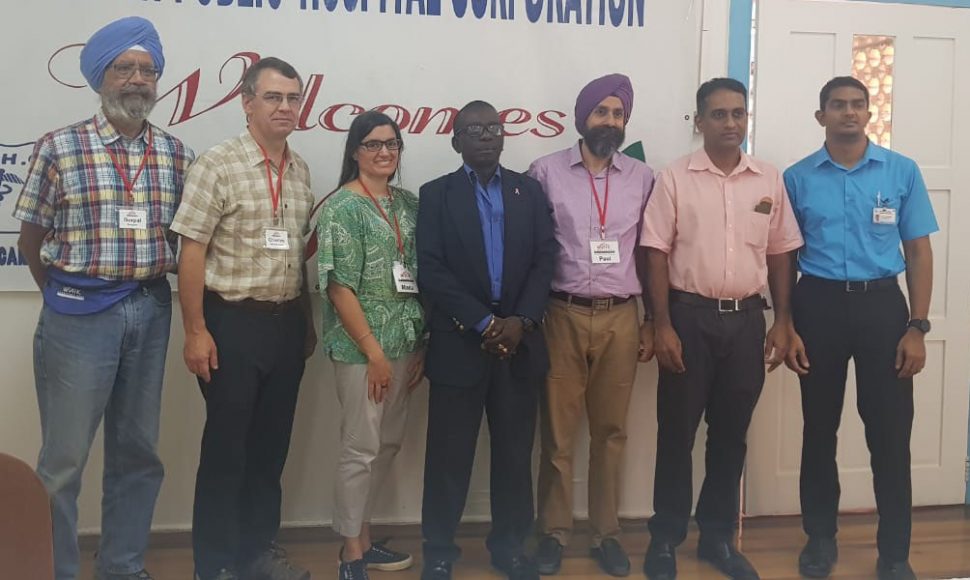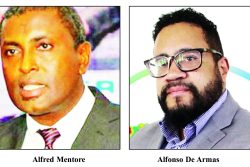A collaboration between the Georgetown Public Hospital Corporation (GPHC) and Operation Walk Maryland, saw 47 persons benefiting from much needed joint replacement surgery over the weekend.
Operation Walk Maryland is a private, not-for-profit, volunteer medical service organisation that provides free surgical treatment for patients in developing countries and in the United States.
Speaking at a press conference yesterday, Dr David Samaroo, Head of the Orthopaedic Department at the GPHC, related that attempts were first made to establish contact with Operation Walk Maryland in 2014.
However, he said, this trail went cold until last year when the conversation was once again picked up in hopes of having the team visit Guyana.
Fortunately for the GPHC, the Maryland team visited Trinidad last year for similar surgeries which required them to return to do patient follow-ups. As a spinoff of this, the team was invited to Guyana, and participated in a high-level meeting with the Minister of Public Health and the Chief Executive Officer of the GPHC. This was followed by serious planning earlier this year to have 50 joint replacement surgeries done at the Georgetown Public Hospital.
Dr Samaroo explained that there was a record of 170 patients who required joint replacement surgery. Screening began in April of this year, and was followed by a second one in July, and a final one last Friday, when patients were selected to undergo surgery.
Stabroek News understands that the first four surgeries were done last Friday after the final screening clinic. In the end, the team was able to complete 47 surgeries with 53 joint replacements done between Friday and Monday.
According to Dr Khaleshwar Ramcharran, one of the surgeons in the orthopaedic department at the GPHC, they were able to operate on 47 patients, six of whom required dual procedures, which brought the total to 53 joint replacements being done. He said the team worked on 29 knees and 18 hips, with the former requiring the dual procedures. In terms of patients’ age, he related that three of the patients were below the age of 50.
“At the end of this all, we had a successful Operation Walk project, we didn’t have any significant complications after these surgeries were done and the majority of the patients are very grateful and are very happy,” he added.
Stabroek News understands that the GPHC Orthopaedic Department will continue to follow-up with patients, while a smaller group from the Operation Walk team will return in January for follow-up.
Founder of Operation Walk Maryland, Dr Paul Khanuja, in his remarks, commended the Guyanese team for their diligent efforts which contributed to the success of the project in Guyana.
Ninth
“…this is our ninth trip that we have done internationally and I have to say that it is the most successful trip, one part (of) what has made it that way is the efforts here in Georgetown…from our initial meeting with the Ministry of Health and the great support from (GPHC CEO) Brigadier (George) Lewis. We came in January and said there are a few things we will need to be in place before we can feel comfortable doing such a volume of surgeries in the time period of time and they were very helpful in making that happen,” he said.
“And then the Department of Orthopedics, Dr Samaroo, Dr Jeffrey and Dr Ramcharran, the scope of the work they did in preparing these patients to have them ready for us was extraordinary and it’s by far the most diligent of work I have seen in any of our Operation Walk trips…there is a whole lot of commitment and passion involved and it was really good to see,” Dr Khanuja added.
Meanwhile, Dr Samaroo, in offering some financial context to the project, explained that locally, joint replacement surgeries are offered at private institutions at a cost of almost $1.5 to $2 million per patient. That fee includes the hospitalisation period and all the fees associated with that operation.
At the GPHC, patients are asked to pay $200,000 to help offset the cost of the implants. However, with Operation Walk, patients were able to undergo surgery free of cost, while those who would have already paid their $200,000 and were awaiting surgery, will be refunded their monies.
The Head of Department observed that with the assistance from Operation Walk, they were able to conduct 53 surgeries in three and a half days, which according to him is commendable since GPHC records show that they have only been able to achieve 45 surgeries in the last three and a half to four years.
“What this team managed to achieve in three and a half days, we were trying to put together things to get that done in the last three and a half to four years,” Dr Samaroo said, before reiterating his gratitude to the 50-member team for their work.
In response to questions from the media regarding the hospital’s inability to complete these surgeries on their own, the Head of Department said that though they have asked patients to subsidise the cost by paying the $200,000, there is still a difficulty in conducting the surgeries as frequently as they wish because of the high cost attached to it.
He disclosed too that the GPHC, over the past six weeks, had published Expressions of Interest for the supply of joint implants to the hospital. However, the response was limited.
Nonetheless, they have invited five companies to do a presentation of their products; from these, two companies will be selected to become supply agents of implants to the hospital.
In addition to procuring equipment for this kind of surgery, Dr Samaroo said the curriculum for the diploma programme, which has been running for the past two years, is being upgraded through a partnership with the World Orthopedic Association from the UK.
A candidate has also been identified to participate in a master’s programme in Orthopedics which is expected to commence soon.
Meantime, CEO Lewis, said the hospital is taking a holistic approach to build capacity for this kind of operation in years to come.
The sustainability of the programme, he noted, is dependent on the development of the hospital’s human resources, the acquisition of equipment and materials for the programme, as well as building the capacity of other hospitals to carry out these surgeries, which, he said, has already begun with the deployment of doctors in both Essequibo and New Amsterdam for this specific purpose.
“The intent is that over time, those institutions will be able to take on more orthopaedic surgeries thus reducing the backlog…It is a holistic plan that we have and we will continue to develop it with the aim of it being sustainable,” the CEO said.
Lewis expressed gratitude to the Operation Walk Maryland team for their work. “The Ministry of Public Health, the Board, Administration and staff of the GPHC are indeed grateful and thankful to Operation Walk team for coming here and performing the orthopedic (surgeries), and at the same time, reducing the backlog. More importantly, I wish to say thank you to Operation Walk Maryland for the joy they have brought to the faces of those patients. They more than us, you have brought mobility back to some of them and I am certain that with the wonderful jobs that you did, even their families benefitted.”





